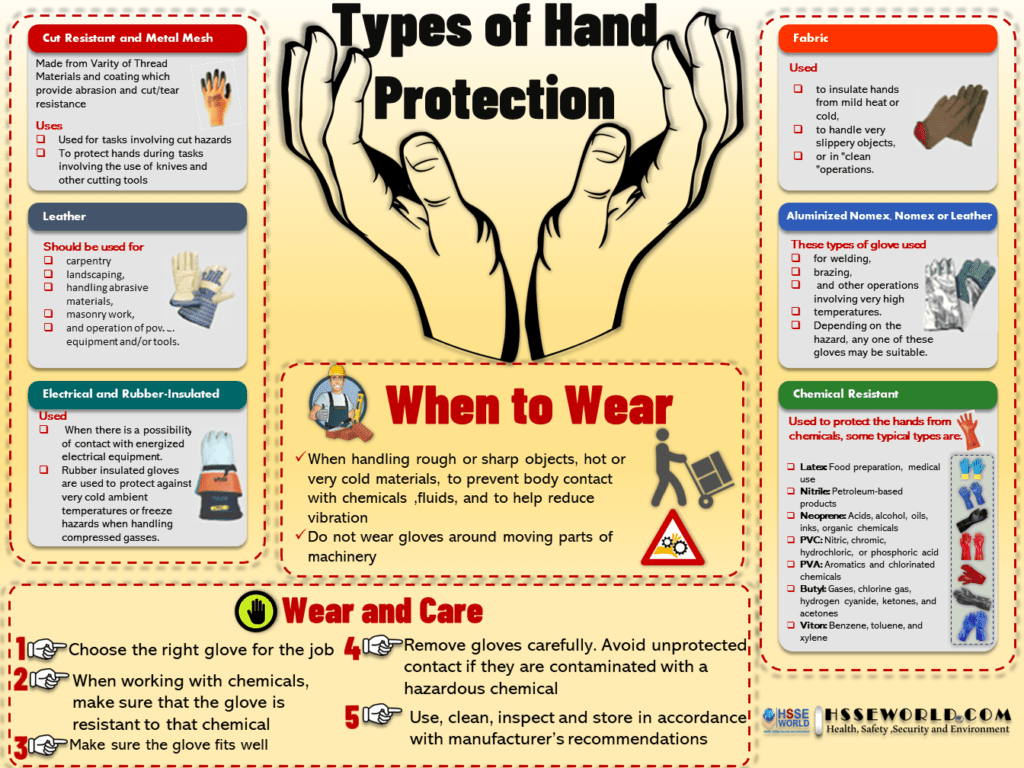Photo of the day: Types of Hand Protection
According to OH&S, hand accidents account for between 40 to 60 percent of recordable workplace incidents. Selecting a pair of gloves to work goes beyond finding the right fit and form. Different types of work safety gloves offer different types of hand protection. Rather than use a one-size-fits-all approach, there are certain gloves you’ll want to use for specific jobs.
There is a wide variety of workplace safety gloves used as personal protective equipment (PPE) on the job. Even within the same industry or at one place of business, workers may need several types and/or grades of gloves. Luckily, suppliers have hundreds, if not thousands, of different gloves in order to satisfy practically every application’s safety requirements. Keep in mind that workers need to be trained to use the right gloves and to use them properly; for example: avoiding hazards such as entanglement in machinery.
In the Photo of today, you will be familiar with Different types of Hand protection and how to select the proper type of glove fit for your Job.
(Read more: how-to-choose-the-right-safety-gloves-12-types-of-hand-protection-gloves/ )

Choosing Workplace Safety Gloves /Types of Hand protection For Your Industry
When choosing the proper workplace safety gloves for a task, consider the following types:
Surgical/Exam: When worn and disposed of properly, these gloves protect from exposure to blood or bodily fluid in a medical or first aid setting. They may also provide limited protection from chemical splash or contact, depending on the type of glove material, chemical, and the time of contact. Best practices dictate the immediate replacement of exam gloves following chemical contact.
Electrical Insulating: These gloves are designed to protect employees qualified under OSHA 1910.269 when working within the Minimum Safe Approach Distance (MSAD) of exposed energized conductors. Gloves must be tested for defects and removed from service when beyond their service life. Non-qualified workers should not attempt any work within the MSAD of live circuits.
key factors to Find the right glove
Leather: Designed for welding or for other general purposes, welder’s gloves have gauntlet cuffs that cover the workers’ sleeves to prevent the trapping of welding spatter.
Cut-Resistant: Depending on the level of hazard and the type of work environment, options include stainless steel mesh, Kevlar Fabric, and other materials for lighter weight cut resistance. Stainless steel mesh is often used for food contact since it can be cleaned and sanitized easily.
Chemical Resistant: These gloves are made from many different materials and include different cuffs, lengths, and thicknesses. Be sure to choose your gloves based on the chemical resistance to the substance you will be using and the job conditions. Consult the safety data sheet (SDS) for the chemical in use for the appropriate glove material.
Heat Resistant: Many general-purpose gloves will provide heat protection, especially gloves made with woven padding or exterior. For extensive work with hot material or for temperature extremes as with foundry work, specialized gloves may be necessary to prevent burns.
Q & A: What kind of gloves are best for stick welding?
Cold Resistant: Many types of gloves will also provide some protection against the cold, but it is important to consider the type of work. Working in a freezer is much different from working outside. Be sure to use waterproof gloves for any job where the worker’s hands can get wet. For heavy work that can damage the gloves, be sure to have extra gloves available.
A common question from employers and employees is, who has to pay for workplace safety gloves and other PPE? In most cases, the employer is required to pay for PPE needed on the job, even if a labor contract says otherwise. The few exceptions to the OSHA rule include ordinary prescription safety eyewear, ordinary steel-toe boots, and ordinary or weather-related clothing and gear that OSHA expects workers to supply on their own.
Protect your employees and protect your company. Provide the right workplace safety gloves and PPE, make sure it’s used, and make sure it’s used properly! you can select your proper gloves from HERE
Download the photo
Now you can download the Infographic ” Types of Hand Protection” and post it at the workplace and communicate with everyone to be familiar with Types of Gloves and how to choose the Right Gloves that fit the Job.
Photo of the day: Types of Hand Protection
More photos:
- What are the Best Practices for Managing Subcontractor Risk
- Photo of the day: 10 Essential Safety Tips for Driving in Hot Weather Conditions
- Photo of the day: best workplace safety tips
- Photo of the day: The Importance of Stop Work Authority in Maintaining Workplace Safety
- Photo of the day: Tomorrow’s Reward for Working Safely Today: Cultivating a Culture of Safety
- Photo of the day: Preventing slips and trips at work
- Photo of the day: Learn the DRSABCD action Plan
- Working with Electricity Electrical Accidents Guide for Electrical Workers
- Photo of the day: Hearing Protection Device Selection
- Photo of the day: If An Earthquake Shakes You-Infographic free
- Fire Safety Posters Free Download
- Photo of the day: First Aid for Electrical Burns-Infographic free
- Infographic: First Aid for Cuts and Scrapes free download
- Photo of The day: Work Safe with Lasers-Laser Safety free
- Photo of the day: Working Safely with chemicals and chemical Management
- Photo of the day: Safe work practices when using MEWPs ( updated)
- Photo of the day: Preventing Common Kitchen Hazards
- Photo of the day: Safe handling of Gas Cylinders and lecture bottles
- Photo of the day: Forklift Stability Triangle
- Photo of the day: Defective Tools Safe Work Practice
- Photo of the day: Lift With Your Legs Not With Your Back
- Photo of the day: First Aid for burns
- Photo of the day: The 7 Principles of HACCP
- Photo of the day: Working Safely with Suspended Loads
- Photo of the day: Heat Stroke First Aid and safety posters
- Photo of the day: Near-Miss Reporting and Posters
- Photo of the day: Ergonomic chair and office chair safety tips
- Photo of the day: Whole Body Vibration
- Photo of the day: Substation Safety Equipment
- Photo of the day: Bypassing Safety Controls Rules
- Photo of the day: Lightning Safety Tips
- Photo of the day: Overhead Power lines Clearance
- Photo of the day: Floor Marking
- Photo of the day: Types of Foot Protection
- Photo of the day: Types of Hand Protection
- Photo of the day: Lockout and Tagout Safety
- Photo of the day: Fall Protection Plans
- Photo of the day: Flood Safety Tips
- Photo of the day: Read All Labels Work safe
- Photo of the day: Run Project safely with Crane Hand Signals
- Photo of the day: Flagman and Traffic control
- Photo of the day: Managing Risks of Exposure to Solvents in the workplace
- Photo of the day: Scissor Lift Safety
- Photo of the day: HSE Bulletin Board
- Photo of the day: Arc-Fault Circuit Interrupters (AFCI)
- Photo of the day: Safe use of ladders and step ladders
- Photo of the day: Concrete Truck Driver Hand Signals
- Photo of the day: Extension Cord Safety Tips
- Photo of the day: Protect your Head
- Photo of the day: choosing the right Anchorage
- Photo of the day: Work-Related Asthma
- Photo of the day: Top FIVE Heavy Equipment Construction Site Safety Tips
- Photo of the day: sun safety in the workplace
- Photo of the day: Cannabis and Impairment in the Workplace
- Photo of the day: Position for safety and comfort-Safety Tips
- Photo of the day: Generator Safety
- Photo of the day: Controlling COVID-19 in the Workplace-Physical Barriers
- Photo of the day: Manual Material handling
- Photo of the day: Personal Protective Equipment last resort
- Photo of the day: WHMIS 2015 – Pictograms
- Photo of the day: Indoor Air Quality
- Photo of the day: Noise in the affected workplace
- Photo of the day: Fatigue at Work
- Photo of the day: Don’t be Driven to Distraction
- Photo of the day: working in heat and Humidex Rating
- How to use Plate Clamps Safely: Safety Moment#34
- Photo of the day: Sitting at work
- Photo of the day: 5 ways to reduce the risk of Slipping and Tripping
- Photo of the day: Preventing the spread of contagious illness
- Photo of the day: Incident Investigations
- Photo of the day: 10 Scaffold Safety Essentials
- Photo of the day: Effective Health and Safety Committees
- Photo of the day: New worker Orientation & Safety Orientation checklist
- Photo of the day: Workplace Inspection
- Photo of the day: musculoskeletal disorders
- Photo of the day: Emergency preparedness in the workplace
- Photo of the day: Mental health in the workplace
- Photo of the day: Trenching Safety Tips That Can Save a Life
- Photo of the day: Dangerous Goods Classes
- Photo of the day: Safety Equipment for Confined Spaces
- Photo of the day: Tips to reduce Heat stress in the workplace
- Photo of the day: hierarchy of controls
- Your steps to chemical safety
- H2S Gas and how to handle its Emergency
- Photo of the day: Importance of Mock drill and Fire Action Emergency Procedure
- Photo of the day: Choosing the Right Face Mask and the difference between a respirator and face mask
- Photo of the day: Confined space safety Precautions
- Breath Safely: The Proper Use of Respiratory Protection
- Photo of the day: Electric shock survival
- Photo of the day: Chemical Spill Emergency Response
- Photo of the day: Construction Site fire Safety
- Photo of the day: Confined Space rescue
- Photo of the day: Conveyors Safety Tips




